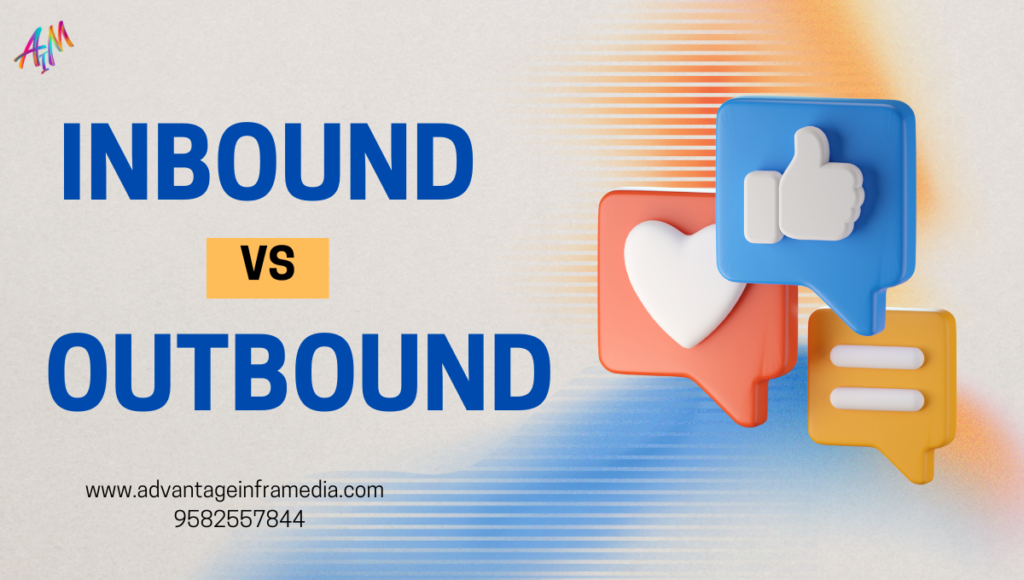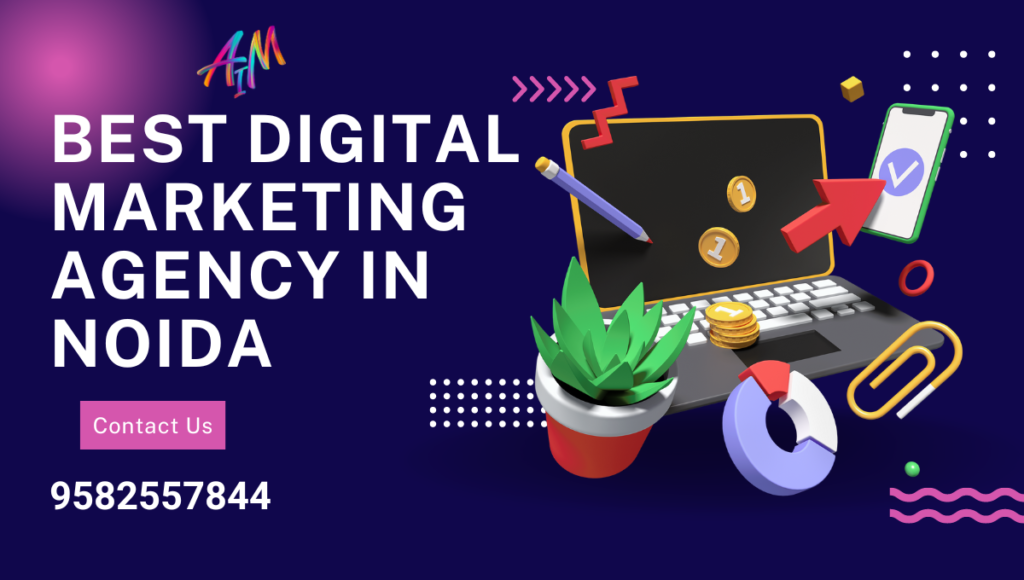Introduction
Marketing strategies have evolved significantly over the years, and businesses are now faced with the choice between inbound vs outbound marketing. Understanding the differences between these two approaches is essential for crafting a successful marketing plan that aligns with your business goals. In this blog, we will explore the key distinctions between inbound vs outbound marketing, their advantages and disadvantages, and how to choose the right strategy for your business.
What is Inbound Marketing?
Inbound marketing is a strategy that focuses on attracting customers through relevant and helpful content, rather than pushing products or services directly. It is a customer-centric approach that aims to create value and build trust with potential customers by providing them with the information they are actively seeking. (Inbound vs Outbound marketing)
Key Components of Inbound Marketing
- Content Creation:
- Blog Posts: Writing informative and engaging blog posts that address the needs and pain points of your target audience.
- Ebooks and Whitepapers: Offering in-depth guides or reports that provide valuable insights on industry-related topics.
- Social Media: Sharing content on social platforms to engage with your audience and drive traffic to your website.
- SEO (Search Engine Optimization):
- Optimizing your content with relevant keywords to rank higher in search engine results, making it easier for potential customers to find your business.
- Lead Nurturing:
- Email Marketing: Sending personalized and targeted emails to nurture leads and guide them through the buyer’s journey.
- CRM Integration: Using customer relationship management tools to track and manage interactions with leads and customers.
- Engagement:
- Social Media Interaction: Engaging with your audience through comments, shares, and direct messages to build relationships.
- Community Building: Creating a sense of community around your brand by fostering discussions and interactions.
Advantages of Inbound Marketing
- Cost-Effectiveness:
- Inbound marketing is generally more cost-effective than outbound marketing. By focusing on content creation and organic traffic, businesses can achieve significant results without a large advertising budget.
- Long-Term Results:
- Inbound marketing strategies, such as SEO and content marketing, build over time. Once your content gains traction, it can continue to drive traffic and generate leads for years. (Inbound vs Outbound marketing)
- Building Trust and Credibility:
- By providing valuable information and engaging with your audience, inbound marketing helps establish your brand as an authority in your industry, building trust with potential customers.
- Targeted Audience:
- Inbound marketing allows you to attract and engage with a highly targeted audience who are already interested in what you have to offer.
Disadvantages of Inbound Marketing
- Time-Consuming:
- Inbound marketing requires consistent effort over time. Creating high-quality content, optimizing for SEO, and nurturing leads can be time-intensive.
- Delayed Results:
- Unlike outbound marketing, where results can be immediate, inbound marketing often takes time to show measurable outcomes. Patience is key. (Inbound vs Outbound marketing)
- Complexity:
- Implementing a successful inbound marketing strategy requires a deep understanding of your audience, content creation, SEO, and data analysis.
What is Outbound Marketing?
Outbound marketing, often referred to as traditional marketing, involves pushing your message out to a large audience, regardless of whether they are interested in your product or service. This approach is more direct and aims to reach as many people as possible to generate leads and sales. (Inbound vs Outbound marketing)
Key Components of Outbound Marketing
- Advertising:
- Television and Radio Ads: Broadcasting commercials to reach a wide audience.
- Print Ads: Placing advertisements in newspapers, magazines, and brochures.
- Digital Ads: Running paid campaigns on search engines, social media platforms, and websites. (Inbound vs Outbound marketing)
- Cold Outreach:
- Cold Calling: Reaching out to potential customers via phone to pitch products or services.
- Cold Emails: Sending unsolicited emails to prospects in an attempt to generate leads.
- Direct Mail:
- Sending physical promotional materials, such as postcards, catalogs, and flyers, to potential customers.
- Trade Shows and Events:
- Participating in industry events, trade shows, and conferences to showcase products and network with potential customers.
Advantages of Outbound Marketing
- Immediate Results:
- Outbound marketing can produce quick results, especially if the campaign is well-targeted and executed. Businesses can see an immediate boost in leads and sales.
- Broad Reach:
- Outbound marketing allows you to reach a large audience, including those who may not be actively searching for your product or service. (Inbound vs Outbound marketing)
- Brand Awareness:
- Through consistent exposure, outbound marketing can help build brand recognition and awareness in the market.
- Controlled Messaging:
- Outbound marketing gives you full control over the message you want to convey, ensuring it aligns with your brand’s values and goals.
Disadvantages of Outbound Marketing
- High Costs:
- Outbound marketing campaigns can be expensive, especially when using traditional media such as television, radio, and print. Digital ads can also be costly, particularly in competitive industries.
- Interruptive Nature:
- Outbound marketing is often seen as intrusive, as it pushes messages to people who may not be interested. This can lead to negative perceptions of your brand. (Inbound vs Outbound marketing)
- Lower ROI:
- The return on investment for outbound marketing is often lower compared to inbound marketing, as it targets a broad audience with a lower likelihood of conversion.
- Decreased Effectiveness:
- With the rise of ad blockers and increased consumer resistance to traditional advertising, outbound marketing strategies may be less effective in reaching and engaging with audiences.
Comparing Inbound vs Outbound Marketing
When comparing inbound vs outbound marketing, it’s important to consider your business goals, target audience, and budget. Each approach has its strengths and weaknesses, and the right choice depends on your specific needs. (Inbound vs Outbound marketing)
1. Audience Engagement:
- Inbound: Focuses on attracting an audience that is already interested in your industry or products, leading to more meaningful engagement.
- Outbound: Reaches a broad audience, including those who may not be interested, resulting in lower engagement rates.
2. Cost:
- Inbound: Generally more cost-effective, especially for small businesses and startups with limited budgets.
- Outbound: Can be expensive, particularly when using traditional advertising methods. (Inbound vs Outbound marketing)
3. Lead Quality:
- Inbound: Generates high-quality leads who are more likely to convert, as they have actively sought out your content or products.
- Outbound: May produce a higher volume of leads, but the quality is often lower, leading to lower conversion rates.
4. Brand Perception:
- Inbound: Builds trust and credibility by providing valuable content and engaging with the audience in a non-intrusive manner.
- Outbound: Can be perceived as pushy or intrusive, which may negatively impact brand perception.
5. Long-Term vs. Short-Term Results:
- Inbound: Focuses on long-term growth, with strategies that build momentum over time and provide ongoing benefits.
- Outbound: Aims for short-term gains, often requiring continuous investment to maintain results.
Choosing the Right Strategy for Your Business
Deciding between inbound vs outbound marketing requires a careful assessment of your business objectives, target audience, and resources. In many cases, a combination of both strategies can be the most effective approach. (Inbound vs Outbound marketing)
1. Business Goals:
- If your goal is to build long-term relationships with customers and establish your brand as an authority, inbound marketing is the way to go.
- If you need to generate quick leads or increase sales in a short period, outbound marketing may be more suitable.
2. Target Audience:
- Consider the preferences and behavior of your target audience. If they prefer to research and make informed decisions, inbound marketing will resonate better.
- For a broad audience or for products with mass appeal, outbound marketing can help you reach more potential customers. (Inbound vs Outbound marketing)
3. Budget:
- Inbound marketing is often more affordable, making it ideal for businesses with limited budgets.
- Outbound marketing can require a significant investment, so it’s important to ensure you have the resources to sustain a campaign.
4. Industry and Competition:
- In highly competitive industries, inbound marketing can help differentiate your brand by providing unique and valuable content.
- Outbound marketing can be effective in industries where consumers are less likely to actively search for information and need a direct push.
5. Integration of Strategies:
- Many successful businesses use a hybrid approach, combining inbound vs outbound marketing to maximize their reach and effectiveness. For example, you might use inbound marketing to nurture leads and outbound marketing to close sales.
Deep Dive into Inbound vs. Outbound Marketing: 2000 More Words
To further expand on the topic of inbound vs. outbound marketing, we will delve into additional aspects such as the evolution of these marketing strategies, specific tools and tactics used in each approach, industry examples, and insights into future trends. This comprehensive analysis will provide a well-rounded understanding of how these strategies can be applied to various business contexts. (Inbound vs Outbound marketing)
The Evolution of Inbound vs Outbound Marketing
1. The Origins of Outbound Marketing:
Outbound marketing, often referred to as traditional marketing, has its roots in the early days of advertising. From the first printed advertisements in newspapers in the 17th century to the advent of television commercials in the 20th century, outbound marketing has long been the go-to strategy for businesses looking to reach a broad audience.
- Print Advertising: The earliest forms of outbound marketing involved print ads in newspapers, magazines, and pamphlets. These ads were designed to capture the attention of a wide audience and promote products or services. (Inbound vs Outbound marketing)
- Broadcast Media: With the invention of radio and television, businesses gained new platforms to reach consumers. Radio jingles and TV commercials became popular tools for mass marketing, allowing brands to convey their messages to millions of people.
- Cold Calling and Direct Mail: Outbound marketing also includes direct outreach methods such as cold calling and direct mail campaigns. These tactics involve directly contacting potential customers to promote a product or service, often without prior engagement or interest from the recipient.
2. The Rise of Inbound Marketing:
The digital age brought about significant changes in consumer behavior, leading to the rise of inbound marketing. As the internet became more accessible and search engines like Google gained prominence, consumers began taking a more active role in seeking out information. This shift in behavior created a need for a new approach to marketing—one that focused on attracting rather than interrupting.
- Content Marketing: The cornerstone of inbound marketing is content creation. Businesses began producing valuable, informative content—such as blog posts, articles, videos, and podcasts—to attract potential customers. By addressing the needs and interests of their target audience, brands could build trust and establish themselves as industry experts.
- SEO and Social Media: Search engine optimization (SEO) became a critical component of inbound marketing, as businesses sought to rank higher in search engine results pages (SERPs). Social media platforms also emerged as powerful tools for engaging with audiences and sharing content.
- Marketing Automation: As inbound marketing evolved, so did the tools used to manage and optimize campaigns. Marketing automation platforms like HubSpot and Market allowed businesses to streamline lead nurturing, personalize content, and track customer interactions. (Inbound vs Outbound marketing)
Tools and Tactics in Inbound Marketing
1. Content Management Systems (CMS):
A content management system (CMS) is essential for managing and publishing content as part of an inbound marketing strategy. Popular CMS platforms include WordPress, Joomla, and Drupal. These systems enable businesses to create, edit, and organize content easily, as well as integrate SEO best practices.
- SEO Plugins: Tools like Yoast SEO or All in One SEO Pack help optimize content for search engines by analyzing keyword usage, meta descriptions, and readability.
2. Email Marketing Platforms:
Email marketing is a key tactic in inbound marketing, allowing businesses to nurture leads and maintain ongoing communication with their audience. (Inbound vs Outbound marketing)
- Mailchimp: A widely-used email marketing platform that offers automation, segmentation, and analytics features.
- Constant Contact: Another popular platform that provides tools for creating email campaigns, managing contacts, and tracking performance.
3. Social Media Management Tools:
Managing multiple social media accounts and engaging with followers is crucial for a successful inbound marketing strategy.
- Hootsuite: A social media management tool that allows users to schedule posts, monitor brand mentions, and analyze performance across various platforms.
- Buffer: A tool for scheduling and managing social media content, as well as tracking engagement metrics.
4. Analytics and Reporting:
To measure the success of inbound marketing efforts, businesses rely on analytics tools to track key performance indicators (KPIs).
- Google Analytics: A powerful tool for monitoring website traffic, user behavior, and conversion rates. It provides insights into how visitors find and interact with your content.
- HubSpot Analytics: Part of HubSpot’s inbound marketing platform, this tool offers detailed analytics on website performance, lead generation, and customer engagement.
5. Lead Generation and CRM Tools:
Lead generation and customer relationship management (CRM) tools are essential for capturing and nurturing leads throughout the buyer’s journey.
- HubSpot CRM: A free CRM tool that integrates with HubSpot’s marketing platform, offering features for lead management, email tracking, and sales automation.
- Salesforce: A widely-used CRM platform that helps businesses manage customer relationships, track sales activities, and analyze data. (Inbound vs Outbound marketing)
Tools and Tactics in Outbound Marketing
1. Advertising Platforms:
Outbound marketing heavily relies on advertising to reach a broad audience. Digital advertising platforms have become increasingly popular, offering businesses the ability to target specific demographics and measure results.
- Google Ads: A pay-per-click (PPC) advertising platform that allows businesses to display ads on Google’s search engine results pages and partner websites.
- Facebook Ads: A social media advertising platform that enables businesses to target users based on interests, demographics, and behaviors. (Inbound vs Outbound marketing)
2. Cold Outreach Tools:
Cold calling and cold emailing remain common outbound marketing tactics, particularly in B2B industries.
- SalesLoft: A sales engagement platform that helps sales teams automate and track cold outreach efforts.
- Outreach.io: A platform for managing and optimizing cold email campaigns, with features for sequencing, A/B testing, and analytics.
3. Traditional Media Channels:
Despite the digital shift, traditional media channels such as television, radio, and print remain important for outbound marketing, especially for reaching older demographics.
- TV and Radio Ads: These channels offer mass reach, making them ideal for brand awareness campaigns. Businesses can work with media buying agencies to secure ad placements.
- Print Advertising: Newspapers, magazines, and direct mail campaigns continue to be used by businesses looking to reach local or niche audiences.
4. Event Marketing:
Trade shows, conferences, and other industry events are key components of outbound marketing strategies, particularly for B2B companies.
- Event Management Software: Tools like Cvent and Eventbrite help businesses plan, promote, and manage events, as well as capture leads.
5. Retargeting and Remarketing:
Retargeting, also known as remarketing, involves showing ads to users who have previously visited your website or engaged with your brand online.
- AdRoll: A retargeting platform that helps businesses re-engage visitors across the web and social media platforms.
- Google Display Network: Allows businesses to serve retargeting ads to users across millions of websites that are part of Google’s ad network. (Inbound vs Outbound marketing)
Industry Examples and Case Studies
1. Inbound Marketing Success: HubSpot
HubSpot, a pioneer in inbound marketing, is a prime example of how this strategy can drive business growth. HubSpot’s success is largely attributed to its commitment to creating valuable content that educates and empowers marketers. (Inbound vs Outbound marketing)
- Content Strategy: HubSpot’s blog covers a wide range of topics, from SEO and content marketing to sales and customer service. By consistently publishing high-quality content, HubSpot has become a go-to resource for marketers worldwide.
- Lead Generation: HubSpot offers free tools, ebooks, and templates that attract visitors to their website. These resources are gated, meaning users must provide their contact information to access them, generating leads for HubSpot’s sales team.
- SEO and Social Media: HubSpot’s content is optimized for search engines, ensuring it ranks highly for relevant keywords. The company also actively engages with its audience on social media, driving traffic and building a community of loyal followers.
2. Outbound Marketing Success: Coca-Cola
Coca-Cola has long been a master of outbound marketing, using traditional advertising channels to build one of the world’s most recognizable brands.
- Television Advertising: Coca-Cola’s TV commercials are iconic, often featuring catchy jingles and memorable slogans. The company’s “Share a Coke” campaign, which personalized bottles with popular names, was a global success, driving both sales and brand engagement. (Inbound vs Outbound marketing)
- Sponsorships and Partnerships: Coca-Cola has a history of sponsoring major events, such as the Olympics and FIFA World Cup. These sponsorships provide massive exposure and reinforce the brand’s association with happiness and celebration.
- Billboard Advertising: Coca-Cola continues to invest in outdoor advertising, with billboards and posters in high-traffic areas. These ads are designed to capture attention and reinforce brand recognition.
3. Combining Inbound vs Outbound Marketing: Salesforce
Salesforce, a leading CRM platform, effectively combines inbound vs outbound marketing to drive growth and customer acquisition.
- Inbound Marketing: Salesforce offers a wealth of content, including blogs, ebooks, webinars, and case studies. These resources are designed to attract and educate potential customers, positioning Salesforce as a thought leader in the industry.
- Outbound Marketing: Salesforce also invests in outbound tactics, such as targeted digital ads and email campaigns. The company’s sales team uses cold outreach to connect with potential clients, often following up on leads generated through inbound efforts.
- Event Marketing: Salesforce’s annual event, Dreamforce, is a major part of its marketing strategy. The event attracts thousands of attendees, offering networking opportunities, product demonstrations, and keynote presentations. Dreamforce combines the best of inbound vs outbound marketing, generating leads and strengthening customer relationships.
Future Trends in Inbound vs Outbound Marketing
1. The Continued Rise of Content Personalization:
As consumers demand more personalized experiences, content personalization will become increasingly important in inbound marketing. Businesses will need to leverage data and AI to deliver tailored content that resonates with individual users. (Inbound vs Outbound marketing)
- Dynamic Content: Websites and emails will use dynamic content that changes based on user behavior, preferences, and demographics. This approach will help businesses deliver more relevant and engaging experiences.
- AI-Powered Content Creation: AI tools will assist in content creation, allowing marketers to generate personalized messages at scale. These tools will analyze user data to craft content that speaks directly to the needs and interests of the audience.
2. The Evolution of SEO:
SEO will continue to evolve, with search engines placing greater emphasis on user experience and intent. Voice search, mobile-first indexing, and AI-driven algorithms will shape the future of SEO.
- Voice Search Optimization: As voice search becomes more popular, businesses will need to optimize their content for conversational queries and natural language. (Inbound vs Outbound marketing)
- Core Web Vitals: Google’s Core Web Vitals, which focus on page load speed, interactivity, and visual stability, will play a crucial role in determining search rankings. Businesses must prioritize website performance to stay competitive.
3. The Integration of Inbound vs Outbound Strategies:
The lines between inbound vs outbound marketing will continue to blur as businesses adopt a more integrated approach. Combining the strengths of both strategies will enable companies to reach a wider audience and drive better results.
- Account-Based Marketing (ABM): ABM is a strategy that combines inbound vs outbound tactics to target specific accounts. By focusing on high-value prospects, businesses can deliver personalized experiences that drive conversions and long-term relationships.
- Omnichannel Marketing: Businesses will increasingly adopt omnichannel marketing strategies that integrate inbound vs outbound efforts across multiple channels. This approach will ensure a consistent brand message and seamless customer experience.
4. Ethical Considerations in Marketing:
As consumers become more aware of privacy and data security issues, businesses will need to prioritize ethical marketing practices. Transparency, consent, and data protection will be key considerations in both inbound vs outbound strategies. (Inbound vs Outbound marketing)
- GDPR and CCPA Compliance: Businesses must comply with regulations like the General Data Protection Regulation (GDPR) and California Consumer Privacy Act (CCPA) to protect user data and maintain trust.
- Ethical Advertising: Outbound marketing tactics, such as targeted ads and retargeting, will need to be transparent and respectful of user privacy. Businesses that prioritize ethical advertising will build stronger relationships with their audience.
Conclusion
The landscape of marketing is constantly evolving, with both inbound vs outbound strategies playing crucial roles in driving business success. By understanding the strengths and weaknesses of each approach, businesses can develop a comprehensive marketing strategy that leverages the best of both worlds. Whether through content creation, targeted advertising, or personalized experiences, the key to successful marketing lies in delivering value to the audience and building lasting relationships. (Inbound vs Outbound marketing)
As the future of marketing continues to unfold, businesses that embrace innovation, personalization, and ethical practices will be well-positioned to thrive in an increasingly competitive landscape. By staying ahead of trends and adapting to changing consumer behaviors, companies can ensure that their marketing efforts remain effective and relevant in the years to come.




